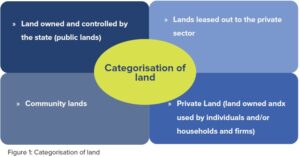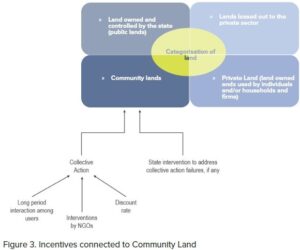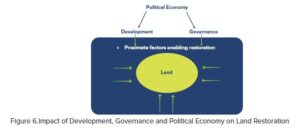Land Degradation in India: A National Systems Perspective on Achievements and Challenges
By V Santhakumar

This Paper was originally published here. It is republished on this website with permissions.
-
Introduction
The need to analyse the restoration of land in each country with a national systems approach is highlighted in an essay recently.1 ‘Different socio-economic factors and policies/institutions together may impact the effectiveness of efforts towards land restoration in different contexts/countries. The contribution of any one factor, say private property rights, may be different in different contexts depending on the presence (or absence) of other enabling factors’.2 This is the rationale for using a national systems approach to view socio-economic and institutional enablers of land restoration.
We use this approach to outline certain achievements and challenges in terms of land restoration in India in this essay. India is the 7th largest country in the world with 3.28 million sq. km and is known for a higher degree of geographical diversity with Himalayan mountains, deserts, humid-tropical parts of South-West, Deccan Plateau, and parts of Sundarbans – the largest mangroves in the world, etc. An important issue is that the country has only 2.4 percent of land of the world though it has nearly one-fifth of the world’s population. Hence the conservation of land in India is important from global and national perspectives. According to one estimate, an area of 96.40 M Ha or 29.32 percent of the Total Geographic Area (TGA) of the country, underwent degradation during 2011-13. The corresponding figure during 2003-05 was 94.53 M Ha (and 23.95 percent of the TGA).3
The basic framework of the national systems approach that is used here is to categorise the whole land into different ownership types, identify the incentives (of different stakeholders) to restore land, and their interactions. Figure 1 summarises this categorisation of land into private lands (owned and used by private individuals/households and firms); community lands (which are owned and/or operated by a community of people); lands leased out to the private sector; and public lands (owned and controlled by the government). The following sections analyse the status and challenges in each category of land in India.

-
Private Land (land owned and used by individuals and/or households and firms)
Incentives or disincentives to degrade/restore private agricultural lands play an important role in determining land degradation at the aggregate level. Factors which may influence these incentives for private landholders are indicated in Figure 2.

These incentives can be shaped by laws, government subsidies, tax rebates, market incentives, the opportunity cost or importance of land (in the life of people), etc. Let’s consider a few of these aspects of India in the following paragraphs.
2.1 Degradation in Private Land in India
The two major causes for the increase in land degradation in the country are vegetation and human settlements.4 Though the former occurs in both public and private lands, the latter is mostly on private land. A major part of the land in India is privately held. In fact, there is no reliable data on publicly held land in India. Though the land owned by different entities, such as the government of India, is notable in absolute size (one account puts it at around 15,500 square km), its share in the TGA is small. Another distinguishing feature is that the average size of landholding in India continues to be very small — only 1.08 hectares in 2015-16.5
India does not have a law or explicit incentives to restore land in privately owned areas, unlike countries like Brazil. The population pressure and the small size of the majority of land holdings make a law that mandates land restoration difficult to implement. Even if incentives are provided, the majority of landowners may not use them. Hence the legal or institutional void in land restoration in privately-owned lands in India is understandable.
Subsidies for agriculture in India generally support intensive or degrading agriculture. These include those subsidies which reduce the cost of fertilisers and pesticides for farmers; and also, that for the extraction of water. Nearly 85 percent of the average cost of electricity for lifting water is subsidised and this can be a major reason for the decline of groundwater tables.6 Though there are schemes for soil conservation or watershed management, their adoption rates are not high.7 The subsidies could not override the cost-benefit calculations of farmers, so they neglected soil and water conservation. There are no major subsidies for agroforestry development or biodiversity conservation in India, even though farmers may sustain or move towards these wherever these are economically attractive.8
The challenges in restoring privately owned land works also against the emergence of private businesses in restoration. The price of land is very high in India compared to countries like Brazil. This will make the potential income from restoration unviable for the survival of the private restoration industry in India. Moreover, there are many challenges for private companies to buy land in the country. Many state governments have imposed land ceilings to avoid the accumulation of land by owners. Such ceilings could be 15-50 acres and these may make restoration projects unviable.9 Though many people may not use the land for cultivation (since they are involved in non-agricultural occupations), they may not sell their land. Land is seen as a speculative asset and the expectation is that its price will increase in future compared to other financial assets. (The underdevelopment of financial markets could be a reason for this state of affairs.) There is also a tendency to not report the actual price of land in legal documents as a way to avoid the reporting of the sources of income and the payment of land registration charges fully, and this can also discourage private companies from buying land (whose accounts have to be legally transparent).10 For these reasons, the governments in India have a tendency to acquire land for industrial development and there is no demand for using this provision for the restoration business.
The demand for (farm) products which do not cause land degradation versus others can be important in this regard. Generally, the cultivation of seasonal food crops and other commercial crops like cotton, sugar cane, soya beans, etc. are likely to cause more degradation.11 Most of the cultivation in India is of this type.12 Organic cultivation is perceived to cause less degradation but the share of land that sustains such cultivation is very small in India.13 In general, plantation and tree crops could be less degrading but the share of these crops is not that high in the country as a whole.14 The wage rate of workers, farmers’ dependence on their own production of food crops, subsidies for the cultivation of food crops, etc. influence the share of seasonal crops. In general, these factors continue to support the cultivation of seasonal crops in India and this can have a negative impact on land.
In summary, the incentives which are shaped by the development status, economic environment and the state together may not enable that much the restoration of privately owned land in India.
-
Community Lands
There is a view that nearly a quarter of India’s land is community owned though an accurate assessment is not possible due to the paucity of reliable data. These community lands include grazing pastures, village commons, and community forests.15 Parts of deserts in Rajasthan or saline lands in Gujarat – which are categorised as degraded land – also may come under community ownership. Possible factors that may shape the restoration of community lands are indicated in Figure 3.

Community lands, which are not forests, do not have either legal measures or state-provided incentives for restoration purposes in India. However social forestry was used to reduce the cost of reforestation (by the provision of seedlings) where communities are interested in planting and nurturing trees. Though informal social norms which sustain the quality of community lands might have prevailed in the past, these may have weakened over time, due to the increase in population depending on such lands, and also other factors such as population growth, mobility of people, dependence on wider markets and so on.16 There are non-governmental initiatives to support some of these communities to protect their lands (and the vegetation over these), and some of these are impactful.17 The cooperative model was also used to regenerate trees in community lands in India, and its impact is also somewhat mixed.18 However, these initiatives are not adequate to counter trends which weaken community norms in this regard.
-
Public Lands
Incentives to protect public land (or that are owned by different tiers of governments) depend on a number of factors and these are indicated in Figure 4.

A major part of public land (about one-fourth of TGA) in India is forests (including national parks), and these are legally owned by the government. Though there was a higher level of deforestation in India in the past, the degradation of remaining patches of natural forest has declined. According to official data, there is an increase in areas covered by forests in the country from 640819 km2 in 1987 to 697898 km2 in 2013.19 There could be apprehensions about the quality of this reforestation but there is a certain level of land restoration in these areas.20 This may be due to the increase in protected areas which may receive a higher level of resources for forest conservation.21 The enhanced awareness on the importance of forest conservation on the part of government officials, increased availability of resources, etc. may have enabled this improvement in forest conservation. However, there were other enabling factors too.
Forests in India came under government ownership during the colonial period and this continued after independence.22 There were efforts to bring forests under private lands and government control later. The scheduled tribes who were traditionally using forests for their livelihood did not have any legal right and they could be denied access or be removed from forests. `They are the least `powerful’ section of Indian society and, hence, their needs, rights and demands could be neglected. Even when some of their rights are recognised under the so-called Forest Rights Act, these are not implemented or enforced seriously’.23
Though the initial interest of governments to own forests was to extract resources (like timber), the increased awareness of the need to conserve the environment from the 1970s onwards has encouraged public authorities to use state ownership to tighten forest conservation.
Since forests are under the direct control of the government, it does not have to compel or persuade private individuals or firms to protect these ecosystems. Moreover, it could avoid the collective action problem in protecting forests (which is a common property resource) that would arise if these were used or controlled by communities. The evidence indicates that all these factors have enabled forest conservation in India.
The other part of public lands is used for industrial and urban development purposes, and there are challenges in restoring these lands.
-
Land Leased out to Private Companies
A part of the land that is owned by governments is leased out to private companies for industrial (including mining purposes) in India. There is a possibility of degradation of this land, and this may depend on a set of factors as noted in Figure 5.

Formal regulation on the use of this land aims at restoration that is possible with these industrial activities. For example, the National Mineral Policy of the Government of India in 1993 (Rules 33(4) and 34) stipulates that `as far as possible, reclamation and reforestation will proceed concurrently with mineral extraction’. There are also mine closure guidelines (issued in 2009) to see that these industrial activities are not environmentally harmful. A restoration plan or environment management plan has to be prepared along with a mining development plan. There are also funds available for this purpose such as that for compensatory afforestation.24 It looks like inadequate human resources and skilful people for this purpose, lack of insistence on the part of regulators, etc., are probable challenges in realising the objectives of these regulations.
Though there are instances where private companies have taken a voluntary interest in restoring land that they have leased for industrial purposes, these cases are rare. There is also a trend where the corporate social responsibility funds of private companies are channelled towards the restoration of ecosystems or vegetation.25 However, the public pressure on the companies to follow the mandates of restoration is also not that high and this could be a factor enabling regulating authorities to take a not so vigilant attitude towards the enforcement.
-
Economic Development and Governance and their impact on land restoration in India
Land restoration also depends on the status of economic and human development and the nature of governance in a country as noted in Figure 6. Some of these connections with respect to India are discussed here.

There are two major manifestations of economic development in India. First is the relatively higher (5 percent plus) economic growth in the country during the last three decades driven mostly by the growth of the service sector. This has enhanced the consumption of the population of the country. A smaller section has become part of richer and middle-class sections. On the other hand, poverty and underdevelopment persist in the country mainly due to the lack of enough quality jobs (especially in the formal sector). Indian economic growth could not create many additional jobs due to the unimpressive growth of its manufacturing sector.26 There are implications of this somewhat jobless growth on land (and its degradation or restoration).
Around half of the population in the country continues to be part of agriculture as farmers and agricultural workers. Given the average size of land holdings, the incomes of the majority of farmers and agricultural workers continue to be low. Yet another section takes up semi-skilled jobs in construction and other such activities which are mainly in the informal sector without adequate social security. Hence, a sizeable section or the majority of the population in India continues to be economically vulnerable (if not poor).
Food and seasonal crops continue to be dominant in major parts of the country. Farmers are compelled to use land in a manner that may not facilitate restoration. Though the movement of people away from agriculture (as the main source of income) may reduce cropping (and fallowing of land which may facilitate restoration) and there are indications of this trend from the state of Kerala,27 It is yet to become a reality in most parts of the country. Even when agriculture declines, the land need not be used in a restoration-enabling manner since there are demands for land for other economic activities.
Given the recent surge in economic development and the fact that a sizeable section of Indians has come out of poverty only recently, the consumption and demand for houses and other basic amenities continue to grow rapidly within the country. This is also reflected in the use of land and its degradation.
There are a number of governance issues which also work against land restoration. Though the laws which are adopted in India are well-meaning and follow global practices, their enforcement is weak. This can be due to a number of reasons such as (a) though the government invests legislature time and resources for making laws, enough resources are not allocated for their enforcement; This can be partly due to weak state capacity which in turn is also connected to the allocation, and the efficient use, of resources; (b) Majority of people are not aware of or concerned about the underlying environmental issue (such as the degradation of land due to mining) and hence the demand for the enforcement of laws from below is somewhat muted. (On the other hand, enforcement of laws such as those aimed at protecting the environment are stronger in those regions where people are aware and active.);28 (c) the effectiveness of the overall institutional system is also problematic as evident from the long delays in deciding cases in the Indian judiciary.29 These delays may create perverse incentives for those who gain from the status quo.
There are other manifestations of not-so-effective governance. Land administration is another case which enhances transaction costs.30 (Its potential impact on those who want to buy land for restoration business is mentioned earlier). Land ceiling legislations can work against the aggregation of land (and its impact on the redistribution of land is also unclear). There are restrictions on what can be attempted in specific pieces of land, and this is a major source of corruption in economic activities which involve the use of land.
-
Political Economy of Land Restoration
Political economy is about the distribution of costs and benefits for different sections (classes) of society and its impact on public policies or actions. It is interesting to look at snippets of political economy which impact land restoration in India. The top levels of the Indian government and elites are ideologically interested in conserving the environment and land.31 They are also influenced by global discourses in this regard. This encourages the government to make appropriate legislations.
One manifestation of this interest is in the tightening of legislations and instruments which are aimed at conserving forests. There are a number of legal attempts in this regard. The power and resources which are available to the forest department have also increased. The availability of international resources for environmental conservation has also enabled this process. All these have led to the tightening of forest conservation in India.
As noted earlier, the fact that forests are owned by governments in India (a residual of the colonial institutional system) has enabled the strengthening of forest conservation. Such a strengthening could happen even though it may have affected directly a section of Indian society, namely, the tribals. They have traditionally lived in and depended on forests. There has been a decline in their access to forests as part of improvements in forest conservation. Even when a law was made to ensure that tribal people have basic access to forests (without leading to their destruction), its enforcement is tardy in most parts of the country. It seems like the interest of the educated middle class, including policy-makers in environmental conservation could override the interests of less privileged tribal communities in this regard. In that sense, the political economy aided by the relative powerlessness of tribal communities may have aided forest conservation in India.
However, the situation is a little different when parts of forests are needed for the economic interests of elites and industrial groups. This is evident from the discussions on projects which allocate forest land for mining and other such purposes. Industrial groups and sections of policy-makers argue for liberal policies in this regard, though these are opposed by sections of environmentalists.32 In essence, forest conservation can be tightened even by neglecting the interests of poorer and marginalised groups but there can be compromises when the interests of mainstream economy and industrialisation are at stake.
Yet another manifestation of the political economy is evident from the contrast between `good’ legislations and their poorer enforcement.33 This can be seen in the enforcement of environmental legislations in general,34 where these are often enforced mainly through the intervention of courts when people file public interest litigations.35 Such poor enforcement is visible in other cases too which have a bearing on land restoration. There are institutional mechanisms that mandate mining land restoration, but these may not be effective in many projects as noted earlier. There are safety standards on what can be carried out in agricultural lands, but these are also not followed generally. 36 In one sense, making the law and leaving the enforcement to social demand is also part of a political economy. The environmental demands of minority elites (and middle-class) and international agreements can be met by making these laws but enforcement without social demand is costly and, hence, it is attempted only where and when there is such a demand. Given the poverty and underdevelopment in parts of India (and the small size of the educated middle class in most parts of the country) such a social demand is muted, and this shapes the outcomes in terms of enforcement of legislations, and this, in turn, impacts land restoration.
AUTHOR
V Santhakumar is Professor, Azim Premji University
Featured photo by Komal Preet Kaur

